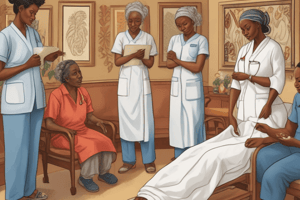Podcast
Questions and Answers
Which of the following is NOT a risk associated with the use of restraints?
Which of the following is NOT a risk associated with the use of restraints?
- Improved mobility (correct)
- Pressure ulcers
- Falls
- Delirium
What is the correct position for the elbows when using a walker?
What is the correct position for the elbows when using a walker?
- Fully extended
- Flexed at 15 degrees
- Flexed at 45 degrees
- Flexed at 30 degrees (correct)
What is the purpose of graduated compression stockings?
What is the purpose of graduated compression stockings?
- To promote venous return (correct)
- To prevent falls
- To reduce joint mobility
- To improve balance
What information must be included in a medication order?
What information must be included in a medication order?
Which of the following is NOT a situation in which hand hygiene should be practiced?
Which of the following is NOT a situation in which hand hygiene should be practiced?
What is the purpose of standard precautions?
What is the purpose of standard precautions?
Which of the following is NOT a principle of sterile technique?
Which of the following is NOT a principle of sterile technique?
What are airborne precautions used for?
What are airborne precautions used for?
Which one of these is NOT one of the rights of medication administration?
Which one of these is NOT one of the rights of medication administration?
What should be checked before administering medication to a patient?
What should be checked before administering medication to a patient?
What is the recommended position for administering oral medications?
What is the recommended position for administering oral medications?
Which type of medication should not be crushed?
Which type of medication should not be crushed?
Which position should a patient be in for the administration of suppositories?
Which position should a patient be in for the administration of suppositories?
What is the recommended angle for subcutaneous injections?
What is the recommended angle for subcutaneous injections?
Which route of administration is used for antibiotics, hormones, and vaccines?
Which route of administration is used for antibiotics, hormones, and vaccines?
What is the purpose of the Z track technique in intramuscular injections?
What is the purpose of the Z track technique in intramuscular injections?
Which of the following is NOT a type of precaution for protecting immunocompromised patients?
Which of the following is NOT a type of precaution for protecting immunocompromised patients?
What is the primary cause of unintentional injuries throughout life?
What is the primary cause of unintentional injuries throughout life?
What is the first step in the RACE acronym for fire safety?
What is the first step in the RACE acronym for fire safety?
What is the last resort for managing a patient's freedom of movement?
What is the last resort for managing a patient's freedom of movement?
Which mode of transmission is identified as the major cause of pathogen spread in healthcare settings?
Which mode of transmission is identified as the major cause of pathogen spread in healthcare settings?
What is the difference between medical asepsis and surgical asepsis?
What is the difference between medical asepsis and surgical asepsis?
When should healthcare workers perform hand hygiene?
When should healthcare workers perform hand hygiene?
Match the following age groups with their primary safety risks:
Match the following age groups with their primary safety risks:
Match the following precautions with their required Personal Protective Equipment (PPE):
Match the following precautions with their required Personal Protective Equipment (PPE):
Match the following procedures with their safety measures during a seizure:
Match the following procedures with their safety measures during a seizure:
Match the following steps of the RACE fire safety protocol with their descriptions:
Match the following steps of the RACE fire safety protocol with their descriptions:
Match the following rights of medication administration with their descriptions:
Match the following rights of medication administration with their descriptions:
Match the following nursing considerations with their definitions:
Match the following nursing considerations with their definitions:
Match the following medication administration types with their characteristics:
Match the following medication administration types with their characteristics:
Match the specific patient groups with their medication administration considerations:
Match the specific patient groups with their medication administration considerations:
Match the following asepsis principles with their descriptions:
Match the following asepsis principles with their descriptions:
Match the following asepsis techniques with their examples:
Match the following asepsis techniques with their examples:
Match the following terms with their definitions:
Match the following terms with their definitions:
Match the following assisted devices with their primary usage:
Match the following assisted devices with their primary usage:
Match the following restraint types with their purpose:
Match the following restraint types with their purpose:
Match the following effects of immobility on the body systems:
Match the following effects of immobility on the body systems:
Match the following medication administration principles with their descriptions:
Match the following medication administration principles with their descriptions:
Match the following medication administration methods with their descriptions:
Match the following medication administration methods with their descriptions:
Match the following injection types with their characteristics:
Match the following injection types with their characteristics:
Match the following steps of insulin injection with their descriptions:
Match the following steps of insulin injection with their descriptions:
Match the following types of insulin with their characteristics:
Match the following types of insulin with their characteristics:
Match the following precautions with their correct descriptions:
Match the following precautions with their correct descriptions:
Match the following principles of sterile technique with their descriptions:
Match the following principles of sterile technique with their descriptions:
Match the following actions with their appropriate containers:
Match the following actions with their appropriate containers:
Match the following diseases with their transmission-based precautions:
Match the following diseases with their transmission-based precautions:




